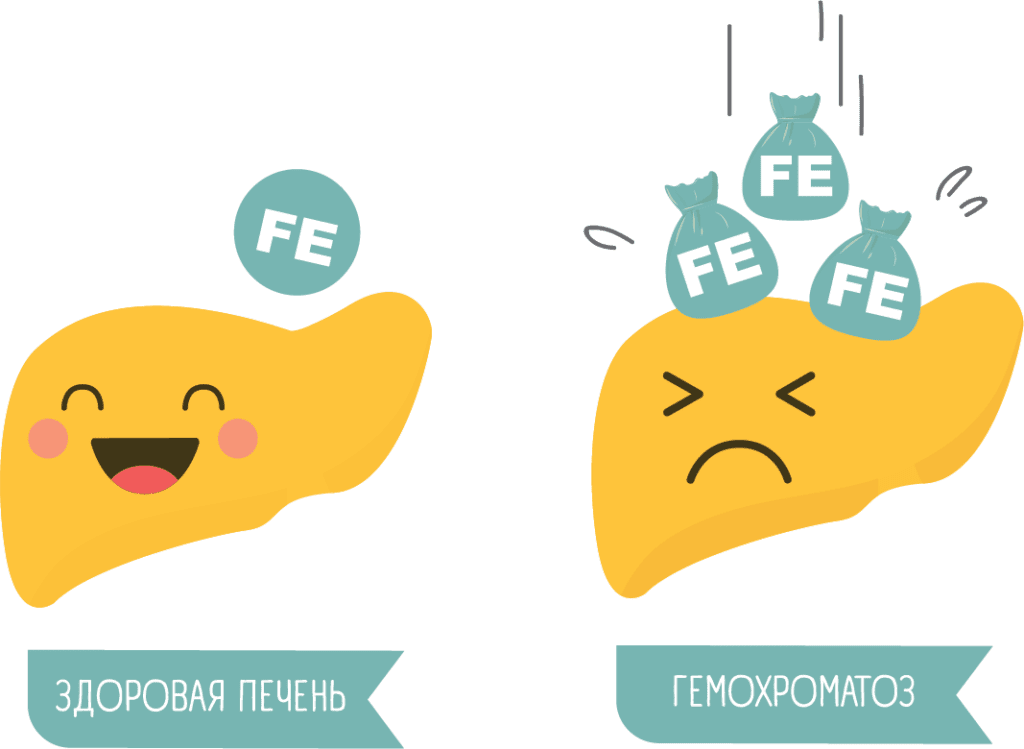HEMOCHROMATOSIS (bronze diabetes) is a hereditary disease in which the body's metabolism of iron is disturbed.
Iron that enters the body accumulates in organs and tissues such as the liver, pancreas, heart, skin, and joints and affects them.

it leads to the risk of developing such diseases:
- Diabetes mellitus
- Irregular heart rhythm or heart attack
- Arthritis (osteoarthritis, osteoporosis)
- Gallbladder disease
- Depression
- Impotence
- Cirrhosis of the liver
- Infertility
- Hypothyroidism
- Hypogonadism
SYMPTOMS OF HEMOCHROMATOSIS
- bronze or gray-brown skin tinge
- weakness and rapid fatigue
- Swelling and pain in the joints
- potency disorder
- pain in the right subcavity
The disease usually first appears in men in their 40s and older, and in women around age 50.

CONTACT
According to the WHO, 10% of the population has a predisposition to hemochromatosis.

Men get sick about 10 times more often than women.

The incidence in the European community is on average 1: 300.

GENETICS
The causes of the disease can be primary (the disease is genetically inherited) and secondary (the disease is acquired during life).
The genetic cause is determined by mutations in the HFE gene.
The incidence is particularly high among the descendants of the Celts (Irish, Scottish, and Welsh), so about 1% of these residents are affected by the disease.


Inheritance of hemochromatosis is of the autosomal recessive type.
This means that two mutated copies of the gene (one from each parent) must be present in the child for the disease to occur.
Usually in a person with the disease, the parents do not have the disease because each has only one copy of the mutated gene. Autosomal recessive disease usually does not occur in every generation of the family.
DIAGNOSTICS
![]()
A positive test result is confirmed in 80% of patients with hemochromatosis;
If a mutation is found, all family members of a hemochromatosis sufferer should be examined. Timely screening will prevent the symptoms of the disease.
![]()
A negative result for the presence of mutations in the HFE gene does not rule out hemochromatosis.
If a negative patient has elevated iron levels, it may be the result of a hereditary liver disease, so additional tests are performed to evaluate the concentration of iron in the liver. In this case, the diagnosis of hemochromatosis can be made on the basis of biochemical tests and histological examination (liver biopsy).
TREATMENT
Treatment of hemochromatosis consists of removing iron from the body and restoring or maintaining the functions of damaged organs:
- The easiest way to remove iron is bloodletting (phlebotomy). Bloodletting is performed weekly until the iron level in the blood is normalized. After that, the procedure is performed less frequently and only to maintain optimal levels of the trace element.
- There are also drugs that bind iron and excrete it from the body.
- It is advisable to eat foods that contain less iron.
- Multivitamins containing iron should not be taken. (Some substances, such as vitamin C, promote the absorption of iron in the intestine.)
- It is recommended to give up alcohol.
- To treat diabetes mellitus, cirrhosis of the liver, heart failure and other complications of hemochromatosis, medications are prescribed to reduce the symptoms of the diseases and maintain a normal standard of living.
If you find out in time that you have this hereditary disease, you can prevent the negative effects that excess iron causes your body and live long, preserving your quality of life.

